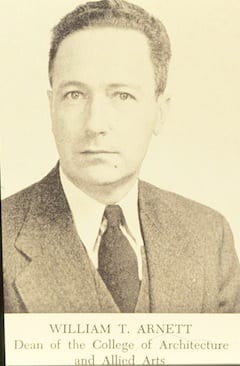In 1925, the newly established School of Architecture at the University of Florida was established within the College of Engineering, offered a four-year program leading to a bachelor of science in architecture. Four years later, the program became an independent unit known as the School of Architecture and Allied Arts in 1929. After a period of development and maturation, the School of Architecture and Allied Arts was first accredited by NAAB in 1948, thus helping elevate the school to college status in 1948. Notably, a four-year program in Interior Design also was formed in the College of Architecture and Allied Arts in 1948 with a curriculum culminating in a Bachelor of Arts in Interior Design. In 1952, the interior design program changed academic homes to the Department of Architecture where a four-year interdisciplinary curriculum in Interior Design leading to a Bachelor of Design with a major in Interior Design was approved. The Department of Interior Design received its first accreditation from the Foundation of Interior Design Education and Research in 1974 and has maintained continuous accreditation for the past 43 years.





1975 Colleges Separated
In 1975, the College of Architecture and Fine Arts divided into two separate entities: College of Architecture and College of Fine Arts. The Department of Architecture gained college status in 1975 and seven years later the interior design program gained department status in 1982 with support from the college faculty, university senate and university president. The Department of Interior Design became one of five academic units in the College of Architecture, including architecture, building construction, landscape architecture, and urban and regional planning. In 1985, the University of Florida was admitted into the Association of American Universities (AAU), confirming the university’s stature as a top-tier research university.
The Department of Interior Design increased its degree offerings in 1999 to include a Master of Interior Design (MID). This action brought the department’s instructional and scholarly activities in line with those of the university and college. This milestone extended the department’s research and teaching mission. In 2000, the College of Architecture was renamed to the College of Design, Construction and Planning. DCP consisted of two schools: School of Architecture and M.E. Rinker, Sr. School of Building Construction, and three departments: Department of Interior Design, Department of Landscape Architecture, and Department Urban and Regional Planning.
Concurrently the DCP doctoral program expanded in 2000 to include all academic units in the college. Another development for the department of interior design involved a new combined degree offering in 2003 that allows advanced undergraduate students to take up to 12 credits of graduate coursework that can be applied to their undergraduate degree and the MID. The 4+1 or combined degree students can then complete the MID in one full year following undergraduate graduation. Similar 4+1 programs were established across the university. In the past ten years, the MID program expanded and then maintained a steady enrollment of about 20 students. During the past decade, the college doctoral program has doubled in enrollment, topping 100 students. During the past 13 years under the current department leadership, doctoral enrollment within the department of interior design grew from one to eleven students. Likewise, the department faculty approved to supervise Ph.D. students (i.e., doctoral research faculty) increased to five (Bosch, Cunningham, Park, Portillo and Valipoor).
In summary, the department has evolved from having a sole focus on providing outstanding undergraduate education to a program that not only offers an excellent undergraduate program but also invests in graduate education. The undergraduate program receives benefits from this structure. Doctoral and MID students often engage closely with undergraduates in roles that support teaching and learning. For example, many MIDs have more life experience, come from different parts of the world, and have undergraduate degrees in fields such as architecture, graphic design, education, or the health sciences. Integrating MID students onto studio teams with undergraduates creates a broader and deeper worldview from which to design.